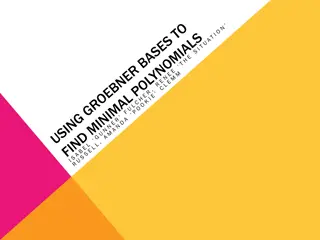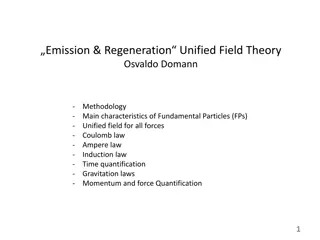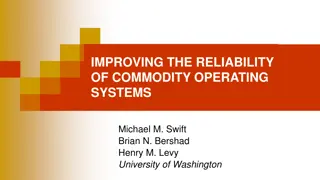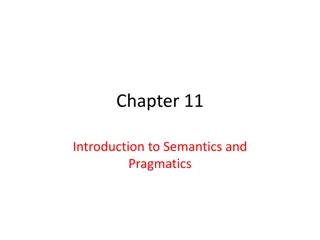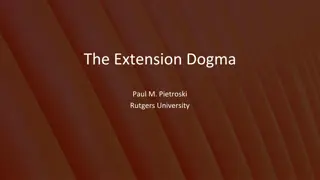Understanding Galois Theory and Field Extensions
Explore the fundamental concepts of Galois theory, field automorphisms, prime subfields, and field extensions. Learn how symmetries and polynomials play a crucial role in creating new mathematical objects, and understand the significance of field extensions in adjoining roots of polynomials. Delve into the concept of splitting fields and how polynomials are uniquely defined by their roots. Enhance your knowledge of algebraic structures and their applications in mathematical fields.
Download Presentation

Please find below an Image/Link to download the presentation.
The content on the website is provided AS IS for your information and personal use only. It may not be sold, licensed, or shared on other websites without obtaining consent from the author. Download presentation by click this link. If you encounter any issues during the download, it is possible that the publisher has removed the file from their server.
E N D
Presentation Transcript
Galois theory SAMUEL HENSHAW
Fields and automorphisms refresher A field F is a set with invertible multiplication and addition such that the distributive property holds. It is a generalization of ?. A field homomorphism is a map to another field that commutes with both operations. They are either injective or trivial. A field automorphism is an isomorphism from F to itself. Field automorphism are invertible and can be composed, so they can form a group.
Prime subfields The field F has a multiplicative identity 1. Let be any automorphism of F. Let k be an element of the form 1 + 1 + + 1 / 1 + + 1 . (k)= ( 1 + + 1 /(1 + + 1))= ( 1 + + 1)/( 1 + + 1)=(1+ +1)/(1+ +1)=k The subfield of all such elements is the prime subfield of F. If F is infinite, its prime subfield is usually ?. If F is finite, it is the ring ?/?? for some prime p.
Fundamental ideas An object s group of symmetries contains important information about that object. Polynomials define algebraic behavior and thus can be used to create new mathematical objects. Galois theory is usually described as the study of field automorphisms and polynomials over fields.
Field extensions When F is a subfield of E, we say that E is an extension of F and write E and E/F. Extensions can be created by adjoining roots of polynomials. The automorphism group of a field is Aut(E). The automorphism group of a field E fixing a subfield F is Aut(E/F). For a prime subfield Q, Aut(E)=Aut(E/Q).
More on field extensions Example: adjoining 2 to ? to get Q( 2) 2 is a root of the irreducible polynomial ?2 2; we define Q( 2) as the set of elements of the form a + b 2 where a and b are rational. This is isomorphic to the quotient Q x /(x2 2). Another example: ?2+ 1 is irreducible over ?. We define ? as one of its roots and adjoin it to get ? ? = ?, which is algebraically closed.
Factoring and splitting fields Polynomials have unique factorizations; they are entirely defined by their roots. A splitting field for a polynomial is the smallest field over which it factors into linear components, or, equivalently, the smallest field containing all of its roots. Example: ?2 2 splits over R because both of its roots are real, but its splitting field is ? 2 .
Galois extensions A splitting field for a polynomial is an extension over which the polynomial factors into linear components. E/F is Galois if and only if E is the splitting field for some polynomial over F. The Galois group of a field extension is the automorphism group of a Galois extension, written as Gal(E/F).
Example and non-example Let ? be the real cube root of 2 and consider ? ? . ? is a root of the polynomial ?3 2, which is irreducible over the rationals. ? ? is a purely real field and this polynomial has two complex roots, so ? ? is not the splitting field for the polynomial. This field is not Galois over ?. 2 and 2 are the roots of the irreducible polynomial ?2 2. Both are in ?( 2), so it contains the splitting field for this polynomial. Conversely, the splitting field contains the generator 2 and thus all of ?( 2), so this is the splitting field and thus a Galois extension. Its Galois group is the group of order 2. ? is Galois over ?.
Fundamental theorem Let K/F be a finite Galois extension. Then there is a bijection between the set of fields between K and F and the set of subgroups of Gal(K/F) such that (E) (E ) if and only if E E . This bijection sends the subfield E to Aut(K/E). The order of a subgroup H is the index of its fixed field in K. K/E is always Galois when E contains F. E is Galois over F iff its corresponding group is normal in Gal(K/F). If E and E correspond to H and H , then their intersection corresponds to <H, H > and EE corresponds to the intersection of H and H .
Applications The Abel-Ruffini theorem The Fundamental Theorem of Algebra The impossibility of trisecting the angle The construction of a regular heptadecagon The proof of the lack of a closed form for the Gaussian integral Cyclotomic field theory used in the proof of Fermat s Last Theorem The Kronecker-Weber theorem
The Abel-Ruffini Theorem Polynomials of degree 5 or above cannot be solved by radicals. Proved using the fact that a polynomial can be solved by radicals iff its Galois group is solvable Polynomials of degree 5 still have general solutions. They can be written with modular forms (I don t know what these are) or in terms of solutions to other specific quantic equations.
Sources Dummit and Foote s Abstract Algebra Professor Vinroot s Galois theory class

 undefined
undefined















